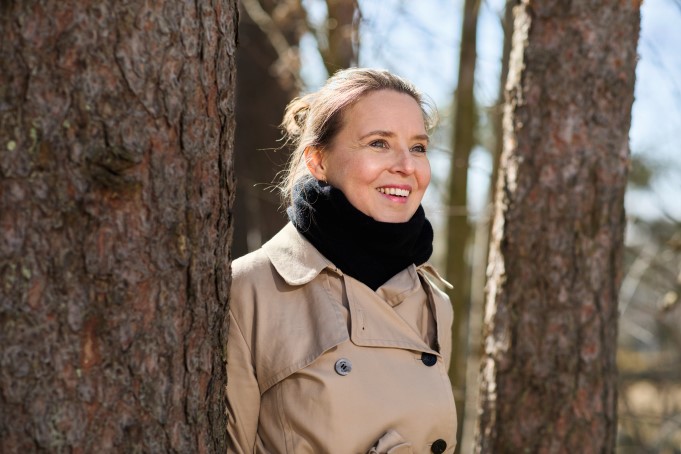According to Metsä Group’s Sustainability Manager Silja Pitkänen-Arte, the changes are positive. “The new standards will increase the diversity of forests. Because PEFC is a commonly accepted method of certification in Finland, this will significantly increase the influence of work to promote diversity.”
Living and dead retention trees
From a forest owner’s point of view, the key changes of the PEFC are about retention trees and buffer zones. Instead of the previous requirement of ten retention trees, the new standard requires ten living retention trees and ten dead trees of at least 20 cm per hectare.
The minimum diameter of retention trees will also be increased from 10 cm to 15 cm. If the felling site does not have enough dead wood, they should be substituted with high biodiversity stumps. Starting with the first thinning, all thinning and regeneration felling operations must leave retention trees on the site.
“Metsä Group has been making high biodiversity stumps at felling sites since 2016, with the permission of forest owners. It’s great to see that this good practice has been included in the certification,” says Pitkänen-Arte.
Metsä Group will continue to make high biodiversity stumps, four for each hectare, to ensure that there is a diverse variety of decaying wood in the forest. If the amount of dead wood in the forest exceeds the amount required by PEFC, the landowner’s permission will be requested for making high biodiversity stumps.
Retention trees provide continuity for decaying wood
Retention trees will continue to consist mainly of deciduous trees and other trees with a low financial value to the forest owner, but a large impact on diversity. Retention trees are placed in groups, primarily in places such as the buffer zones of waterbodies or in the immediate vicinity of valuable habitats or open bogs.
Retention trees are intended to be permanent. Because of this, Metsä Group marks them on maps, so that they can also be taken into account in future felling operations. The intent is that retention trees first grow old and sturdy, and after they die, they provide decaying wood for the forest, which is important for many endangered forest species.
“In our first thinning operations in Southern Finland, we are starting to see these kinds of aging retention trees that have been saved due to PEFC certification. In general, you can see the difference very well,” says Pitkänen-Arte.
Pitkänen-Arte recommends selecting retention trees during the early phases of the forest cycle, because a young forest has more tree individuals and tree species to choose from than a pine forest that is ripe for regeneration or felling, for example.
In the summer, Metsä Group announced that it would stop purchasing deciduous tree species that rarely grow in forests, such as great sallow, bird cherry, rowan tree or alder. “If these tree species meet the diameter requirements of the certificate, they are very suitable for use as retention trees. Also, just like before, any nesting trees of birds of prey, sturdy juniper, large aspen, trees with fire wounds and old retention trees should be used as retention trees,” says Pitkänen-Arte.

Ten-metre buffer zones
The buffer zones by waterbodies will be increased from five metres to ten metres, and only selection cutting will be allowed in the buffer zones. Soil preparation, fertilisation and clearing will not be allowed in the buffer zones. “With this change, 3.5 per cent of forest area will be moved to continuous cover forestry, which is a significant increase,” says Pitkänen-Arte.
The buffer zones serve to protect the state of the waterbodies, and they also support the diversity of species. Ten-metre buffer zones must also be maintained by any open bogs. “The edges and transitional zones of waterbodies are often home to different species than the rest of the forest.” Buffer zones often have high diversity in deciduous tree species.
Thickets in all phases
Thickets are more protected under the new standard. They must be retained in all phases of forestry operations. According to Metsä Group’s guidelines, one protective thicket must be left for every new three-hectare area. A good thicket size is approximately one hundred square metres.
“The revision won’t change Metsä Group’s operating methods, because we have been using protective thickets in forest management for a long time. Of course, in the big picture it is a significant change,” says Pitkänen-Arte.
Suitable places for protective thickets include places like below groups of retention trees. Moist depressions, the edges of ditches and fields, or terrain that is rocky or otherwise difficult to manage are also good places for protective thickets.
More detailed quality monitoring
The revision of the PEFC standard will oblige forest sector operators to collect more detailed data and instruct their employees better. “At Metsä Group, we’ve been conducting systematic quality monitoring internally for a long time. As our company is based on cooperative principles, it’s important to us to ensure that the quality of our forest management services stays high. For example, if young stand management is conducted with care and on time, it will have an effect on the next forest management phases.”
The new criteria will apply to all felling and forest management from 1 February 2023. The new criteria were supposed to enter into force on 1 January 2023, but the change was delayed by one month.
The forest owner’s participation in PEFC certification will continue as before. “Forest certification and the verification of the wood’s origin and sustainability that it allows are important for our end product markets,” says Pitkänen-Arte.
Metsäliitto Cooperative's PEFC logo license: PEFC/02-31-03
This article was originally published in issue 4/2022 of Metsä Group’s Viesti magazine.
Text Maria Latokartano
Photos Seppo Samuli and Metsä Group
